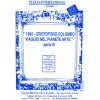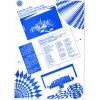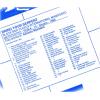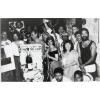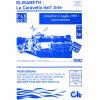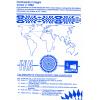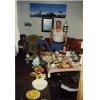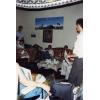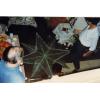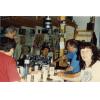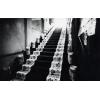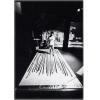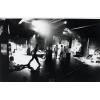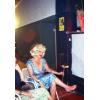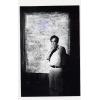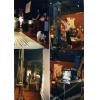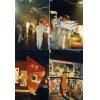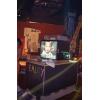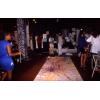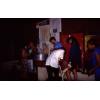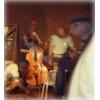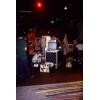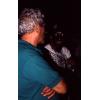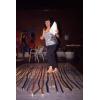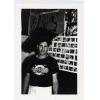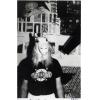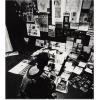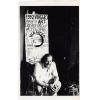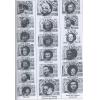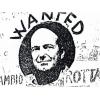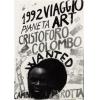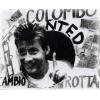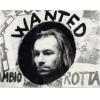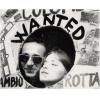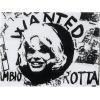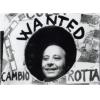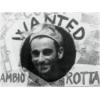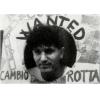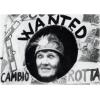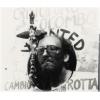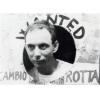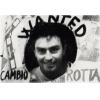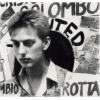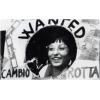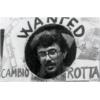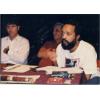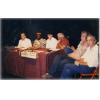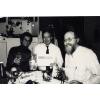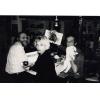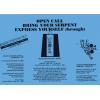On June 30 of 1990, in Rome, at the theatre Ridotto del Colosseo, it was staged 1992 Christopher Columbus Voyage in the Planet of Art, act III: Plexus Black Box. It was organized by Maria Pia Marsala, Sandro Dernini, Giancarlo Schiaffini and Micaela Serino. It was planned as a three days TV theatre laboratory, with no public, to package the Plexus Black Box to be delivered to the anatomy table of the Academy to be open as an alive creature, like a Golem or Frankenstein. It was presented as the departure of a fractal of individual contributions travelling through their own history into the Plexus Black Box.
Free interpretations were made by Willem Brugman, Frans Evers, David Ecker, Arturo Lindsay, Odita Okechukwu, Lynne Kanter, Frank Shifreen, Karl Geiringer, Jeroen Heuvel, Ciro Ciriacono, Fabrizio Bertuccioli, Roberto Federici, Piero Cianflone, Carlo Cusatelli, Vittorio Terracina, Fabi, Anna Piccioni, Mauro Brusà, Elsa Rizzi, Victor Ibanez, Antonio Caboni, Antonello Dessi, Andrea Portas, Loreto Papadia, Giancarlo Schiaffini, Paolo Damiani, Maria Pia Marsala and Sandro Dernini. Before the opening, as a good auspicious, David Ecker cooked a Ganesh Dinner for everybody and Roberto Federici presented his artwork The Rose of Winds as a guide for the Plexus voyage. The three days laboratory was conceptualized as a modular theatrical construction for a collective artists packaging of the Plexus Black Box to be delivered in Holland to the Laboratory of Plastic Sound of the Royal Conservatory of The Hague directed by Frans Evers. At the opening day, a music performance by Paolo Damiani and Giancarlo Schiaffini, recalled the 1984 Open Call In Order to Survive by William Parker, while individual photo shots were taken of participants as members of the Plexus Telematic Team travelling to the Planet of Art to collect more artworks in support to the Art World Bank project in Goree-Dakar. On July 1, at the Vatican, the 1992 Plexus Columbus Reconciliation project was presented to Mons. Dante Balboni, a religious scholar and director of the High Institute for Sacred Art. The project was to connect symbolically the House of the Slaves in Goree to the Church of the Madonna of the Slave in the island of San Pietro. The day after, this project was presented to the Ambassador of Senegal in Italy, S.E. Youssouph Baro, together with the Plexus proposal of the opening in Goree of the World Art Bank. In the evening, at the Metateatro, Pippo di Marco introduced the round table, Plexus Black Box: A Multicultural Data Bank Departing on the 1992 C. Colombus Route, made with the participation of David Ecker, Odita Okechukwu, Arturo Lindsay, Frans Evers, Fabrizio Bertuccioli, Frank Shifreen, Ciro Ciriacono, and video documented by Sandro Dernini.
From Plexus Report by Arturo Lindsay:
On July 2, 1990, with an audience of artists from Europe, Africa, and the Americas, Plexus convened its first international conference. The panellists consisted of Dr. David Ecker, artist, director of ISALTA (International Society for the Advancement of Living Traditions in Art), co-cordinator of the 1992 Christopher Columbus Consortium, professor of art and art education, New York University; Dr. Okechukwu E. Odita, artist, member of the 1992 Christopher Columbus Consortium, professor of art and African History, Ohio State University; Dr. Arturo Lindsay, artist, scholar in residence, Franklin and Marshall College, Plexus-Atlanta, assistant professor, Spelman College, Atlanta; Dr. Frans Evers, artist, Plexus Amsterdam, professor, Laboratory of Plastic Sound, Royal Conservatory, The Hague, Holland; Mr. Fabrizio Bertuccioli, artist, Plexus Rome; Mr. Frank Sheefren, artist, Plexus-New York; Mr. Ciro Ciriacono, artist, Tempo Irreale, Rome; and Dr. Sandro Dernini, coordinator of the 1992 Christopher Columbus Consortium and originator of Plexus. Each panelist made a presentation regarding his research, work and or vision of Plexus’s future. Along with a discussion of my work with remote control drawing tools, as the Ancestral Messenger of Plexus, I assumed the responsibility of opening our channels of communication by providing each artists in the Plexus network with my vision for Plexus and the enclosed mailing list. My vision for Plexus is to see artists use this mailing list to invite each other to work on international collaborative projects; and to share ideas and resources. I encourage my fellow panelists as well as every member of Plexus to make use of the mailing list to directly communicate with us. I have added to the list of participants at the conference in Rome, the names and address of several other artists who have participated in previous Plexus events. Please forgive any inaccuracies in the mailing list. Misspelled names and address are largely due to my inability to read the artist’s handwriting. Please type or print clearly all corrections as well as names of artists who were omitted and forward to Dr. Arturo Lindsay. I will update the mailing list once a year, or as needed, or as funds allow. The Ancestral Messenger “Definition” of Plexus: The following is a more concrete description of the proposal I presented in Rome. Beginning with a biological definition of a plexus I propose we built an art definition of Plexus as a metaphor. As you will note in the art definition, I have written in italics (originally in bold) letters the transformation into metaphor.
Biological Plexus
The communication which takes place between two or more nerves form what is called a plexus. Sometimes a plexus is formed by the primary branches of the trunks of the nerves – as the cervical, brachial, lumbar, and sacral plexuses – and occasionally by the terminal funiculi, as in the plexuses formed at the periphery of the body. In the formation of a plexus the component nerves, then join, and again subdivide in such a complex manner that the individual funiculi becomes interlaced most intricately; so that each branch leaving a plexus may contain filaments from each of the primary nervous trunks which forms it. In the formation also of smaller plexuses at the periphery of the body there is a free interchange of the funiculi and primitive fibres. In each case, however, the individual filaments remain separate and distinct, and also do not inoculate with one another.
Art Plexus
The communication which takes place between two or more artists form what is called a Plexus. Sometimes a Plexus is formed by the primary branch (Sandro) – as a Co-Opera, a Purgatorio Show, or a Christopher Columbus Project – and occasionally by local Plexuses, as in the plexuses formed in Amsterdam, Dakar, New York, Rome, Sardinia, Milano, and soon Atlanta. In the formation of a plexus the component artists divide, then join, and again subdivide in such a complex manner that the individual events become interlaced most intricately, so that each branch leaving a plexus may contain filaments from each of the primary aesthetic trunks which form it. In the formation also of a smaller plexuses at the periphery of the body there is a free interchange of artists. In each case, however, the individual artist remains separate and distinct, maintaining his/her own identity, and do not inoculate with one another, losing their individuality.

